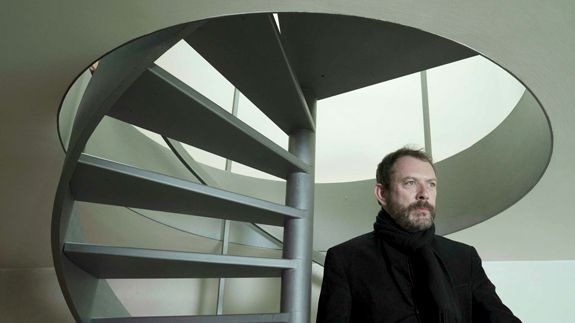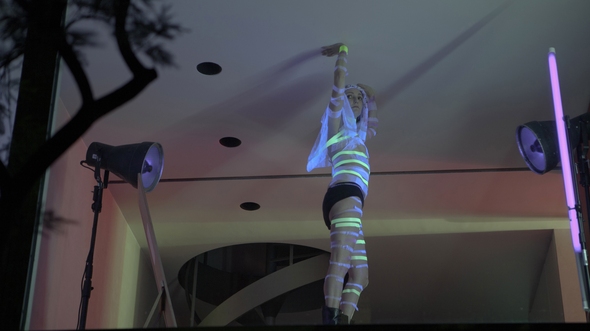Writer/Director: Joanna Hogg
Stars: Viv Albertine, Liam Gillick, Tom Hiddleston
Joanna Hogg’s third film deals in gracious architectural spaces and the upper middle class creatures who fill them. Elegant, mannered, a study in static frames and noises off, Exhibition jettisons plot in favor of vignette, presenting a series of scenes from a marriage that’s neither ideal nor enviable, but, by the end of the movie, has come to make a kind of twisted sense.
Artist D (Viv Albertine) and architect H (Liam Gillick) spend their days creating at their respective desks, occupying separate floors of their London townhouse. They communicate in a rather stilted manner via intercom, implying their relationship has become stiff through overuse. The third party in this marriage is not a child, or a lover, but the house itself, which appears to have grown between them like a tree root, forcing them apart over time.
D certainly seems to have a more intimate relationship with the house than she does with H. She drapes herself around its curves, on a windowsill, a corner wall, a rock in the garden. She seeks approbation and satisfaction in its reflective surfaces. She dons fancy knickers and performs crude burlesque in one of its empty rooms. The house gives her what H will not: tranquil approval of everything she does and is. So she orients herself towards it, usually presenting us (and H) with the back of her head, or the shrug of her shoulders. Only the house is permitted to gaze upon her face.
D and H have decided to sell the house, after 18 years of co-habitation, so D’s interactions with the furniture and windows have a nostalgic quality from the get-go. She must indulge her guilty pleasures while she still can. Consequently, she pushes H, so much less arch and fascinating than the house, away. He attempts to maintain their connection, but the house has intruded on his side of the relationship too. He sees D more clearly in reflections than he does in reality, and can only say “I love you” via the intercom, when he’s insulated from her reaction by the wood paneled walls. Is he reaching out to D, or the echo of who she once was to him?
A brief moment of passion fizzles as D flops on the bed like the proverbial dead fish, unable to ignite even the energy it would take to wriggle out of her clothes. When he asks, “Can’t I play first?” she denies him via complete inertia, wanting him to stick it in and be done. H flails above her, frustrated, completely unable to penetrate the barriers she has erected around her secret self, the one she shares only when alone with the house – with whom, of course, as we’ve already seen, she is only too happy to play.
D and H discuss the previous occupants, the architects who designed and built this suave structure, and lived there into their 80s, when the spiral staircase became too much to navigate. They ponder the possibility of the house absorbing this couple’s lifelong love into its edifice, and, by implication their own. Although they’ve decided to move on, they feel it’s important to preserve the house as it is, a monument to love and regret. They ask the realtor (Hogg’s muse, Tom Hiddleston) if they can insert a “No Demolition” clause into their terms of sale. He smirks denial at them. Once they quit possession, that’s it.
Hogg’s eye for negative space is fully utilized here, both in terms of the stylized photography and in the force that drives the narrative. Exhibition’s truths are more easily located in cavities rather than content – often in a punning manner, as when H gets into a fight with a builder who has impinged upon his parking space, or when another contractor discusses the width of the gap between the elevator car and the shaft. D and H have identified themselves with a restrictive structure for too long. It’s only on occasions when they break free, out onto the streets of London, that they are able to access emotional honesty, as when D, alarmed by the wailing of emergency sirens, runs outside in her underwear to check that no accident has befallen H, showing more concern for his well-being in that moment than in any of the scenes inside the house thus far.
The house in Exhibition is not just an enviable address but an all-encompassing lifestyle. As young artists, D and H required a frame, and they found one they thought was perfect within the clean modern lines of the house. But, over the 18 years they’ve lived there, the frame has become a constraint. The house contains and confines them in ways that go beyond walls. For the sake of their love, their careers, their sanity, they must move on. By the time they’re slicing into a replica house cake at a party to celebrate the sale, symbolically destroying their des res, it’s hard not be glad they’re making their escape to a more creative and fulfilling future.
Held together by two mesmerizing central performances from Albertine (former Slits guitarist) and conceptual artist Gillick, Exhibition is an inventive study of the way structure affects content. We are where we sleep. Outwardly precise and mannered, inwardly quite chilling, there are also some darker lessons in here about covetousness, about contemporary obsessions with property values, and a warning that if you gaze long enough into architectural interstices, they will gaze also into you.
Exhibition will screen as part of AFI Fest 2013 on Monday, November 11 @ 7:30 p.m., at Chinese 3 and on Wednesday, November 13 @ 4:15 p.m., at Chinese 2

